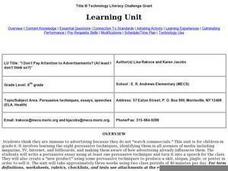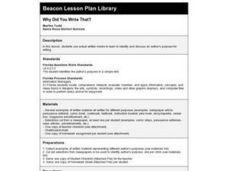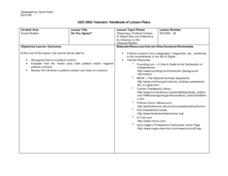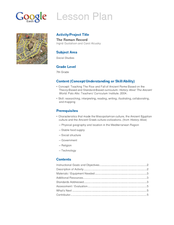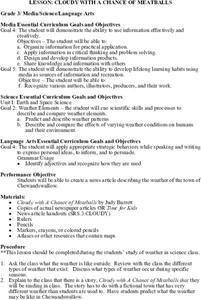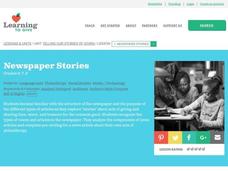Roald Dahl
Matilda - The Third Miracle
Magnus takes a visit to the classroom in the 20th chapter of Matilda. Or does he? After reading, learners interview the person in the hot seat to get a detailed account of what happened during this chapter. Then, they write individual...
Library Sparks
Reference Tools Vocabulary Challenge
Learners love the opportunity of going to the library to jump into that one comfy chair in the whole room with a book, or be a lucky one to get to the computers before anyone else. But knowing how to locate books and other reference...
Curated OER
I've Got News For You!
Students explore their hometown newspaper for ideas. They create their own classroom newspaper.
Curated OER
The Art of Violence
Violence and human suffering, as represented in art and film, are the focus of an investigation of the power of visual images and the moral implications of such representations. Class members examine “Guernica,” Pablo Picasso’s massive...
Curated OER
Operation Iraqi freedom
Students explain the term "public agenda' and identify the characteristics and components of the media. They read newspapers, watch and listen to newscasts to determine the media's position on the war in Iraq.
Curated OER
Easy Access: Creating Annotated Versions of News Articles
How can news coverage be made more accessible for teens? Model for your class how to use technology to annotate news stories containing unfamiliar references that hinder their interest in and understanding of a news story. Use the...
Curated OER
American History Operation Iraqi Freedom
Students consider the responsibilities of American troops. In this Operation Iraqi Freedom lesson, students watch video segments regarding the work of the Arkansas National Guard. Students research media sources to determine the balance...
Curated OER
Lessons to be Learned: The Importance of Attribution, Accuracy, and Honesty
Students investigate real world examples of media law issues. In this media law instructional activity, students read Janet Cooke’s feature and respond to the writing. Students read articles by Stephen Glass to highlight facts...
Curated OER
I Don't Pay Attention to Advertisements
Sixth graders examine the eight persuasive techniques, identifying them in all avenues of media including magazine, TV, Internet, and billboards, and making them aware of how advertising already influences them. They write an essay using...
Curated OER
"I Don't Pay Attention to Advertisements? (At least I don't think so?)"
Sixth graders study eight persuasive techniques that occur in a variety of media types. They write a persuasive essay and present it to the class. They create a "new product" for which they produce an advertisement using persuasive...
Curated OER
Objective Versus Subjective
Students examine the difference between subjective and objective statements, newscasts, and media. They discover that subjective is opinion based and objective is fact based.
Curated OER
Why Did You Write That?
Second graders use actual written media to identify and discuss an author's purpose for writing. They identify the author's purpose in a selection from the newspaper, and write a short description of how they came to their conclusion.
Curated OER
Do You Agree?
Students recognize bias in a political cartoon, evaluate how the media uses both positive and/or negative political cartoons, and assess the influence a political cartoon can have on a person.
Curated OER
Design Your Own Cereal Box
Pupils explore the ways in which media messages work and the ways in which consumers are targeted.
Curated OER
Caldecott Medal Winners
Second graders identify Caldecott Medal winners. In this library media lesson, 2nd graders view an overhead transparency of Caldecott Medal winners from 1987-2004 and answer questions based on the data that is displayed.
Visa
The Influence of Advertising
Pupils become informed consumers and citizens with this lesson on the influence of advertising, identifying basic advertising techniques and discriminating between fact and claim in modern advertisements and commercials.
Curated OER
Recycled Paper
Sixth graders keep track of the amount of paper they consume on a daily, weekly, and monthly basis. The goal of the lesson is to have them all find ways to reduce the amount they use. Everyone creates recycled paper from old newspapers...
Curated OER
Get in the Newspaper Habit
Dive into journalism with your high schoolers! The resources provided here will help your learners write unbiased, clear, and succinct newspaper articles. First they spend time sifting through stacks of articles, filling out a graphic...
Curated OER
The Penny Press, Walt Whitman and the War
Students examine the Penny Press and how it began the era of mass circulated newspapers. They use the internet to research the writing style of the paper and write a short article using that style.
Curated OER
Africanized Honey Bees And The Press
Students investigate how honey bees and other insects are portrayed in the press. read the articles and compare and contrast the tone of each article. Have students create a list of the verbs used in each article and assess the overall...
Teachers' Curriculum Instituted
The Roman Record
Using Google Earth, Google Docs, and other Google Tools, collaborative groups of seventh graders research and then create and share online newspapers reporting on the early development, geographical features, political issues, and...
Curated OER
Cloudy With a Chance of Meatballs
Third graders discuss the weather and how it changes during the different seasons. They listen to a read aloud of Judy Barrett's, Cloudy With a Chance of Meatballs. They write and illustrate a news article about the weather that is found...
Curated OER
Newspaper Stories
Students examine the structure of the newspaper. In this newspaper lesson, students look at the different types of articles about giving, sharing, and acts for the common good. They realize the types of voice that are used in the...
Curated OER
Bias
Students apply techniques of distinguishing between fact and opinion. Students identify words associated with persuasion and argument. Students read and categorizer a variety of newspapers and articles. Students identfy bias in a...










